Introduction
Research is a quest for knowledge through diligent search (or) investigation (or) experimentation aimed at the discovery and interpretation of new knowledge.[1] Research inculcates scientific and inductive thinking and it promotes the development of logical habits of thinking and organization. Information technology is playing a major role in research in terms of data acquisition, interpretation and dissemination of results. It had revolutionized the field of bioinformatics. This has spurred increased research activities worldwide including India.
Research in India is still in its infancy. There is urgent need for reorganization of the valid research data in India. This will help in formulating national dental health care policies and evidence based clinical practice. Most of the research projects - be it epidemiological, preventive, experimental, clinical or non-clinical are of short-term nature and academic oriented. Fewer long term studies are available.[2] Most of the multinational companies present in India carry out periodontal research to propagate their innovative products; however, their results may sometimes be biased. In this review an attempt made to analyze periodontal research and its effect on periodontal practice in India.
Progress of Periodontal Research and Practice in India
Until 1960, the concept of specialist was not developed in India. With the commencement of postgraduate education in India in 1959, Orthodontics achieved a status of specialty as it was something new concerned with aesthetics. Periodontics as a specialty received very little attention during 1960-70s probably because little was known about the pathogenesis and management of periodontal diseases. The scientific advances made since then have constructively helped us to understand the disease and alter our treatment accordingly. The dental profession has now fully recognized the importance of periodontics as a clinical specialty.[3]
Research Facilities and Activities.
Research facilities and activities are absolutely essential for the progress of the dental health care system in India. Most of the research is carried out in dental institutions as a part of post graduate studies. The modern studies require sophisticated equipments. This requirement has resulted in a wide knowledge gap between the developed world and the institutions located in the less developed countries. Uniform modernization of laboratory facilities in all the institutions is an issue that has to be addressed at war footing. This will help promote quality research all over the country.
Deficiency in skilled, trained, competent and willing technicians makes the maintenance and efficient use of facilities difficult. Most of the sophisticated instruments are imported and that spares and trained troubleshooters often have to fly in from overseas. This requirement has to be fulfilled.[2] The migration of skilled researchers and technicians to well developed countries in search of lucrative jobs is another issue that the government of India need to address. National policies which make the entire dental practice and research lucrative should be formulated to prevent the brain drain. But care should be taken against spurious commercialization of research.
Funding of research is another important issue. Several funding agencies are now available from department of public health. Indian medical council for research is one of the premier funding agencies with several institutes all over the country.[4].
International Clinical Dental Research organization was established in 2008 with the objective of promoting dental research in India. It is dedicated to motivate clinicians & academicians to take more interest in clinical research. It also provides funds to support research studies / dissertations[5]. The progress of the profession is very much dependent on the research activities. But the deficiency of technical knowledge of attaining funds among researchers has led to disappointment and loss of desired results. Health department has the responsibility to encourage the interested researchers by simplifying the funding regulations and reduction of outright rejections of research proposals. Basic training should be given to all health science faculties in writing a proposal, carrying out the research, fund management and publishing results.
Health Departments in most of the states give a low priority to dental research work. Meager funds are allotted to Dentistry. These funds do not fulfill the required objectives due to improper handling. A huge deficit exists between the amount of research work carried out and published work. This issue needs to be addressed[5]. Inspite of deficiencies periodontal research has been progressing steadily. Large number of dissertations has been written during the last four decades on various aspects of Periodontology (see Table 1).
Many multinational companies have excellent research facilities in India, but very little research work is published by them. Ayurvedic companies are also conducting research on their products and their works are not regularly published. Several in vitro studies and animal studies are also being conducted all over the country.[6]
Research Activities in various fields of Periodontics - Most studies seem to have focused on research topic relevant to the Indian environment. Topics covered are mentioned in the Table no. 1
Etiological factors: Great deal of research work has established multifactorial nature of periodontal disease and mechanism leading to loss of attachment apparatus. [7],[8]
Risk factors: Many risk factors modify the response to periodontal diseases (Table 2).
In India, there has been an explosion of interest and research in this area. Many dissertations & researches on risk factors in the Indian scenario have been conducted and published[9], [10], [11]
 | Table 1: Dissertation Topics from Indian Institutions.
 |
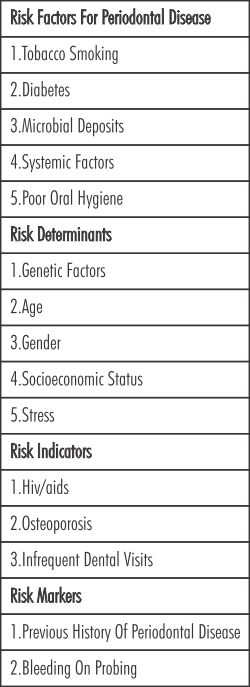 | Table 2: List of risk factors
 |
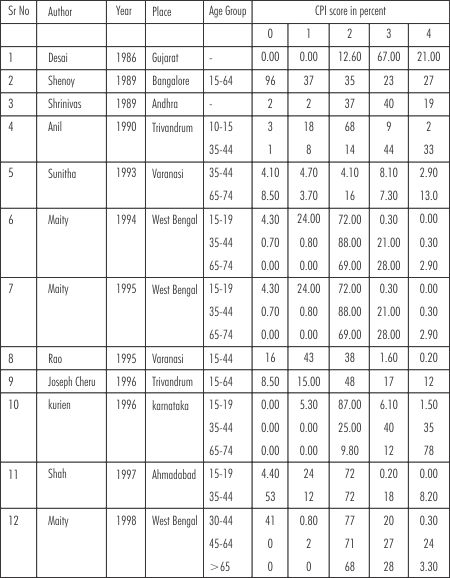 | Table 4: Various Epidemiological Studies Conducted in India.
 |
Epidemiology: Many scattered epidemiological studies have been carried out in India. But results have been varied and conclusion cannot be drawn. (Refer Table 3, 4, 5)
Oral health in India:
A muticentered oral health survey was conducted in India in the year 2004 under a collaborative programme by Government of India and WHO. Few of well documented studies have been shown in the Table 5.
Plaque Control:
The Indian system of medicine has given great importance to oral hygiene as an essential part of the general health. Many people do not use tooth brushes but they use miswak sticks or fingers to clean their teeth (Refer table 6). However, in urban and semi-urban areas, tooth brushes are slowly replacing traditional methods. Effective employment of public health tools are required to improve the understanding and awareness of the results of research among general public. This could help translate research into practice.
Studies on indigenous herbs like neem, turmeric, miswak, pomegranate etc have gained importance in the recent years. Research on various interdental aids,dentifrices, mouth rinses & indigenous tooth cleansing methods are being conducted . This has resulted in development of quality indigenous products & has brought down the cost factor which is an important concern in developing countries.
Therapeutic treatment modalities
![Table 3: Various Epidemiological Studies Conducted in India.1 [*M-Male], [*F-Female]](article-image-2271-TABLE_3_VARIOUS_EPIDEMIOLOGICAL_STUDIES_CONDUCTED_.jpg) | Table 3: Various Epidemiological Studies Conducted in India.1 [*M-Male], [*F-Female]
![Table 3: Various Epidemiological Studies Conducted in India.1 [*M-Male], [*F-Female]](images/article-image-enlarge.jpg) |
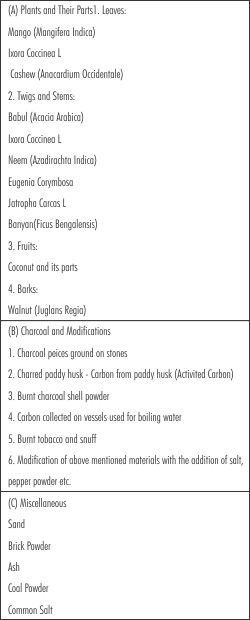 | Table 6: Indigenous Oral Hygiene Methods in India13
 |
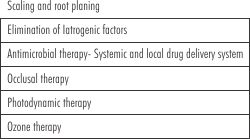 | Table 7: Non surgical Therapy
 |
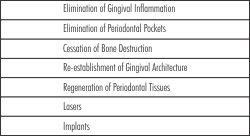 | Table 8: Surgical Therapeutic Modalities – Objectives
 |
 | Table 5: Prevalance data of periodontitis from various studies done on Indian population.12
 |
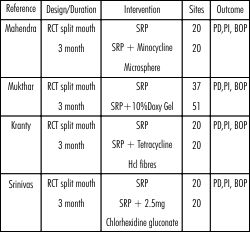 | Table 9: Characteristics of the included studies by design and agent vehicle.14
 |
 | Table 10: Various regenerative procedures
 |
Conventional treatment modalities for periodontal disease is shown in Table 7 & 8
Nonsurgical therapy;
Antimicrobial Therapy: Administration of systemic antibiotics has been beneficial in periodontal treatment. But they have several problems associated with their use in the treatment of periodontal diseases. Three approaches to antimicrobial therapy have been studied. These include
1. Systemic administration: amoxicillin ,metronidazole combination & ciprofloxacin combination have been found to be effective.[9]
2. Topical administration: various mouth rinses & herbal drugs are being studied. Conflict of interest cannot be completely ruled out.
3. Controlled release devices: Resorbable & non resorbable drug delivery system have been studied. Systematic review on the efficacy of local drug delivery system is presented in the [Table 9].
All the above studies reported reductions in gingival inflammation, plaque scores, and bleeding indices in both the control and the experimental groups. It was concluded that use of antimicrobial sustained-release systems as an adjunct to SRP does not result in significant patient-centered adverse events. Local drug delivery combined with Scaling and root planing appears to provide additional benefits in pocket depth reduction compared with Scaling and root planing alone. Systematic reviews of the data in Indian population is the need of the hour.
Lasers:
Extensive studies are being carried out in different research institutes under the watchful eyes of the regulatory bodies like Indian Laser Association and laser institutions. Lasers have been used inNonsurgical therapy, surgical pocket therapy,Photodynamic therapy,Lasers for implant place ment, treatment of periimplantitis, Dentinal hypersensitivity, low level laser therapy, soft tissue procedures like Depigmentation, frenectomy, frenotomy Systematic reviews and meta analysis of these studies are awaited.[16]
Regenerative therapy:
Several animal & human studies are being carried out on various regenerative approaches. Sri chitira research institute has been instrumental in bringing out quality indigenous allografts & GTR membranes(Periobone G, Periocol) . Extensive studies are being done on various regenerative materials at the institutional level and the research centers. But systematic reviews and meta analysis of studies being conducted in India is needed (Refer Table 10).
Periodontal Medicine:
It is a new branch of Periodontology that has developed. It describes the bidirectional interrelationship between the systemic and periodontal diseases. It is a relatively new topic. It has gained momentum very quickly. Several studies are being conducted in various institutions in collaboration with hospitals. This is an encouraging development in periodontal research in India. ICMR has recently initiated research proposal to assess the relationship between periodontitis and preterm labor and low birth weight implants.
The available research data and future data should be subjected to intense scrutiny to separate sham research from original. These studies have to be subjected to meta-analysis and published in accessible reputed journals. This strong data should form the foundation of public health education. There is no dearth of information among our clinician and researchers. But proper orientation through basic training could do a world of good. Attempts should be made to systematically document, analyze and interpret data. Screening of research for authenticity and appropriate utilization of funds will encourage periodontal research in India.
A collaborative approach between the Public health dentistry and Periodontology is required to improve the quality of dental care. A definite collaborative strategy could bring about radical changes in the public perception and understanding of periodontal research. This approach could help develop effective means of public health education and provision of advanced periodontal care to each and every citizen of our country and not to only the privileged few.
Conclusion:
Scientific enquiry is one of the most challenging enterprises of mankind and the support it receives is the measure of strength, vitality and vision of the society. The approach and methods of research have slowly evolved to become more precise and efficient. The tendency is to explore the unknown. Periodontal research has gained a lot of momentum in the present decade. Funding of research has promoted many clinicians and academicians to indulge in active research. Various research centers of global standards are being set up in India. Bioinformatics is available at a mouse click. There is a need to conduct muticentered randomized controlled studies and systematic reviews because we are in an era of evidence based dentistry. There is a need to set up research database which can be easily accessed. Information sharing among various institution and research centers are required. Periodontal research in India has to create its own identity in the global scenario. The ultimate aim of the research should be to benefit the so called 'common man'.
References
1. Kothari CR. Research methodology and techniques. 2nd ed. Research methodology: An introduction, Chapter 1, 1-29. Wishwa prakashan. New Delhi.
2. Champaklal Pranlal Boghani. Progress of periodontal research and practice in India, Progress of Periodontal Research and Practice in Asian Pacific Countries Edited by: P.M.Bartold, I.Ishikawa, M.Sirirat © 2000 Asian Pacific Society of Periodontology chapter 8, 76-96
3. Boghani CP. Editorial. Bulletin Indian Soc Periodontol 1996; 2:33.
4. Indian council of medical research Apex body for the formulation, coordination and promotion of biomedical research .www.icmr.nic.in/.
5. International Clinical Dental Research Organization (ICDRO), is an organization dedicated to bring dental research in India to the fore frontwww.icdro.org/
6. D'Silva. The effect of neem gel on plaque and gingivitis. J Indian Soc of Periodontol 1999; 2:63.
7. Pal. Studies onimmuno-potential of bioceremic of perio: An immunological essay. J Indian Soc Periodontol 1999; 2:69.
8. Veerandrakumar. Role of silicon in calculus formation. Bulletin Indian Soc Periodontol1995;19:64
9. Mythilli. Antibiotics therapy in periodontitis: The evaluation of controlled release devices.Bulletin Indian Soc Periodontol 1994; 18:4.
10. Baiju, Nandakumar. Smoking and periodontal diseases. Bulletin Indian Soc Periodontol 1998; 1:12.
11. Nilema SM. Diabetes mellitus; systemic modifier in periodontal disease. J Indian Soc Periodontol 1999; 2:48.
12. Boghani, Shankwalkar. Exfoliative cytology study in panchewers and bidi smokers. J Indian Soc Periodontol 1963; 1:23.
13. Jacob S et al. Prevalence of periodontitis in the Indian population. A literature review.JISP , vol (15), Issue 1, Jan- Mar 2011.
14. Bhatt. Dessertation submitted by Philladi to Mangalore University, 1999.
15. Rupali K, Vandana KL, Shobha P: Effect of local drug delivery in chronic periodontitis patient: A Meta-analysis. J Indian Soc Periodontol. 2011 ; 15(4): 304-309.
16. Mythilli. Antibiotics therapy in periodontitis: The evaluation of controlled release devices.Bulletin Indian Soc Periodontol 1994; 18:4.
17. Vanaja KN, Sangeetha S, Dhayanand JV. Lasers in periodontics- A scientific boon or bane. SRM university journal of dental sciences. 2010; 1(1): 91-98.
18. Singh GP, SONI B J. prevalence of Periodontal disease in urban and rural area of ludhiana, punjab, indian j community med 2005; 30:128-9.
19. Mahendra RC, Chandrashekar KT, Vandana KL. The efficacy of Arestin (minocycline HCL 1 mg) micrispheres in the treatment of chronic adult periodontitis (Dissertation). Bangalore, India: RGUHS; 2004.
20. Mukhatar, Shobha prakash, Vandana KL. Comparative evaluation of Atridox (10% Doxycycline hyclate) with SRP in the treatment of periodontitis: A clinical study (Dissertation). Bangalore, India: RGUHS; 2001.
21. Kranthy KR, Kala SB, Prakash S. Clinical and microbiological evaluation of periodontal plus AB in the treatment of periodontitis (Dissertation). Bangalore, India: RGUHS; 2006.
22. Sreenivas R, Shobha prakash, Mehta DS. Comparative evaluation of sustained local drug delivery of chlorhexidine (PerioChip) and phase I therapy in the treatment of chronic periodontitis (Dissertation). Bangalore, INDIA: RGUHS; 1998.
23. Doifode VV, Ambadekar NN, Lanewar AG. Assessment of oral health status and its association with some epidemiological factors in population of Nagpur, India. Indian J Med Sci 2000;54:261-9.
24. Jagadeesan M, Rotti SB, Dananbalan M. Oral Health status and risk factors for dental and periodontal diseases among rural women in Pondicherry. Indian J Community Med 2000; 25:31-8.
25. Ranganathan K, Magesh KT, Kumarasamy N, Solomon S, Viswanathan R, Johnson NW. Greater severity and extent of periodontal breakdown in 136 south Indian human immunodeficiency virus seropositive patients than in normal controls: A comparative study using community periodontal index of treatment needs. Indian J Dent Res 2007; 18:55-59.
26. Ranganathan K, Umadevi M, Saraswathi TR, Kumarasamy N, Solomon S, Johnson N. Oral Lesions and conditions associated with Human Immunodeficiency Virus infection in 1000 South Indian Patients. Ann Acad Med Singapore 2004; 33:37-42.
27. Parmar G, Sangwan P, Vashi P, Kulkarni P, Kumar S. Effect of chewing a mixture of areca nut and tobacco on periodontal tissues and oral hygiene status. J Oral Sci 2008;50:57-62.
28. Rooban T, Rao A, Joshua E, Ranganathan K. Dental and oral health status in drug users in Chennai, India: A cross sectional study. J Oral MaxilloFacial Pathol 2008; 12:16-21.
29. Sood M. A study of epidemiological factors influencing periodontal diseases in selected areas of district Ludhiana, Punjab. Indian J Community Med 2005;30:70
30. Singh GP, Soni BJ. Prevalence of periodontal diseases in urban and rural areas of Ludhiana, Punjab. Indian J Community Med 2005;30:128-9
31. Vandana KL, Reddy SM. Assessment of periodontal status in dental fluorosis subjects using community periodontal index of treatment needs. Indian J Dent Res 2007; 18:67-71. |